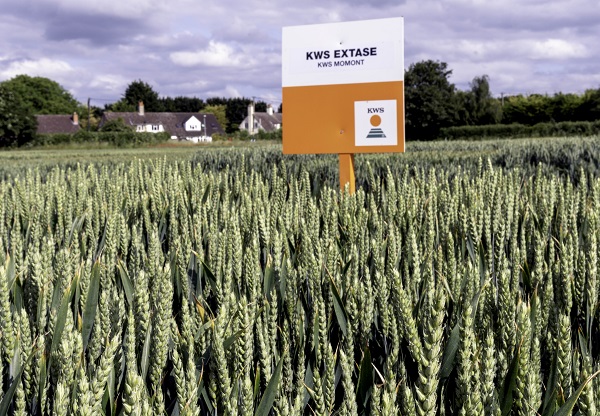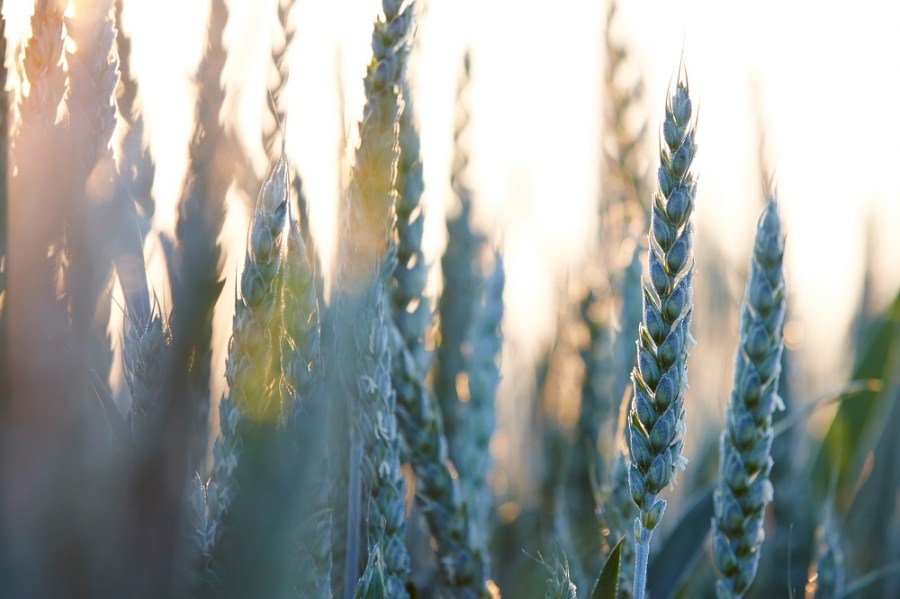As challenging seasons become the norm, wheat growers may find themselves taking a closer look at genetic attributes in order to ensure they’re including the most resilient varieties within their rotations. CPM reviews six market contenders.
Disease resistance contributes to consistent performance.
By Charlotte Cunningham
It’s been a challenging season so far for wheat growers, with cropping areas and yields predicted to be notably lower than usual on the back of little to no activity during the main autumn drilling window.

Barry Barker reckons growers will be looking carefully at the genetic attributes their variety choices bring.
As a result, when it comes to planning for next year’s harvest, the fallout from this year’s series of events may dictate more strategic variety selection, according to Barry Barker, national arable seed product manager at Agrii. “The general mood is that this year has been so difficult that many growers will find it a challenge to maintain profitability. Quite a few aren’t wanting to spend much more on this year’s crop because of the low yield potential, and next year, I think growers will be looking carefully at the genetic attributes their variety choices bring.”
Barry reckons growers are going to be more likely to look to the most resilient wheats to put themselves in the best position against adversity. “Disease resistance contributes to consistent performance. So as well as providing comfort to growers, resilient, robust types also give them the opportunity to review their inputs when disease pressures are low.”
But with 35 varieties on the 2020/21 Recommended List, and many others available on the market, what makes the cut when it comes to Barry’s top six resilient wheats?
KWS Extase
Kicking things off is KWS Extase, a Group 2 milling wheat, with a robust disease package. “KWS Extase could well be the biggest selling variety this autumn,” says Barry. “There’s a lot of buzz around it, not only because of its grain quality, but also due to its very good disease resistance.”
Scoring an 8.1 for septoria, 9 for yellow rust and a respectable 7 for brown rust, Barry reckons the variety is likely to tick a lot of boxes for growers. “For those looking to manage their inputs more carefully in the coming season, this robustness will mean they’re able to practice more flexibility – rather than just following a standard, prescribed programme.”

With a score of 8.1, KWS Extase is the first variety to achieve a ranking of over 8 for septoria resistance in the UK.
The only thing missing from the package is orange wheat midge blossom (OWMB) resistance, so it’s important to be aware of the implications this may have, he adds. “For most of the country, KWS Extase is going to be an incredibly good option, with a high market share likely.
“However, in the long term, it’s important to remember that any variety that gleans a high market share could have its resilience compromised as disease pressure builds, so mixing up your choice helps to protect the longevity.”
According to breeder, KWS, Extase’s disease resistance package marks a new era in untreated yield performance. “It’s headline resistance to septoria and unrivalled untreated yield are the showstoppers for KWS Extase,” says Kirsty Richards, value chain manager at KWS. “While its septoria resistance score and untreated yield of 10.6t/ha are impressive, it’s also the highest yielding of all the premium wheats on the current RL so it responds well to investment, too.
“Overall, it’s KWS Extase’s combination of flexibility, disease resistance and strong physical traits that means it is most likely to achieve its full yield potential in the real world.”
KWS Extase derives from French heritage and is a Boisseau x Solheio cross, with the Boisseau line – from Azur plant breeding – bringing good resistance to lodging, yellow rust, mildew and, of course, septoria, she adds. “Solheio is a KWS Momont line that also boasts good resistance to yellow rust and septoria, as well as other attractive grain characteristics.”
KWS Siskin
Though its popularity is slightly declining, KWS Siskin is another Group 2 milling variety from the KWS stable that ticks the resilient box, says Barry. “In the trials we run, KWS Siskin continues to perform well in both treated and untreated trials. We don’t get a high fungicide response, which illustrates good disease resistance.
“It’s also holding up very well in terms of yellow rust resistance, with a score of 9. One of few varieties that still does that.”
While it’s not exactly the new kid on the block, Barry believes KWS Siskin’s parentage is one of the main reasons the variety continues to do so well on the disease front. “KWS Siskin was spawned from a KWS Sterling x Timaru cross, and any variety with that Timaru parentage seems to be very resilient against disease at the moment.”
Though KWS Siskin isn’t one that growers may automatically leap to, it’s a good second wheat choice and is worth considering due to its continually proven disease resistance, he adds. “As it’s a Group 2 wheat, the variety also has the capability to deliver some sort of premium.”
KWS also says there’s additional potential for Siskin growers. “KWS Siskin opens multiple end markets for farmers, unlocking premiums for their shed load of grain,” adds Kirsty. “In addition, it’s consistent across soil types and performs well as both a first and second wheat.
“KWS Siskin has one of the best septoria scores on the List and ranks high for mildew and yellow rust, highlighting the disease profile farmers can expect from KWS Dynamic Wheats.”
RGT Skyfall
While yellow rust resistance in the Group 1 milling variety, RGT Skyfall, has slipped over recent years – scoring a 5 on the 2020/21 RL – what makes it a resilient type is its excellent protection against brow rust, which has been a problem for newer wheats lately, explains Barry. “Looking at the wider disease spectrum, septoria resistance is okay – with a score of 5.8 – but with a rating of 7 for fusarium, it’s probably the most resistant and resilient in the milling wheat category, and also the only widely grown type with OWBM resistance.”
According to Barry, Skyfall has a lot of good attributes and is likely to be the variety of choice for a number of growers this year. “I think particularly for the 2021 harvest, a lot of people will choose to grow Skyfall because of its flexibility in drilling date. With many choosing to target the later end of drilling windows in order to maximise their crop resilience, this is better than anything else on the market.”
Skyfall is also incredibly competitive against grassweeds, which adds to its resilience, adds Barry. “Another unique quality carried by RGT Skyfall is the Pch1 rendezvous resistance gene that gives it good protection against eyespot – something that none of the other varieties here have.”
Tom Dummett, OSR and cereals manager at RAGT says that Skyfall is one of the most widely grown winter wheats, with it also taking a large share of the UK feed wheat market on the back of flexibility in drilling, excellent straw characteristics and very strong agronomics. “It also has a top fusarium rating and is the only Group 1 wheat with OWBM resistance.”
RGT Saki
Having only made it onto the Recommended List this year, RGT Saki is already enjoying a good demand, says Barry. “There’s a range of varieties in the soft section which are all at their peak performance level, or on the decline, – with the exception of Skyscraper – but RGT Saki brings some needed improvements to disease resistance, particularly on the septoria front.”
According to the 2020/21 RL, RGT Saki bagged a 9 for yellow rust, 8 for brown rust and 6.8 for septoria – with the cherry on the cake being OWBM resistance too, he adds.
Barry credits this performance to Cougar being one of RGT Saki’s parents. “If you’re looking for a truly resilient feed wheat variety, then RGT Saki is the best of the bunch.
“While soft wheats don’t always have the strength of genetics that hard and milling types do, it’s important that there’s a reliable option for growers who are looking to be as resilient as possible within their choices, and for me, this is it.”
According to Tom, RGT Saki delivers an impressive package that should equate to solid and consistent performances across all regions.
“RGT Saki’s impressive untreated and treated yield scores offer something completely new to growers.
“Untreated yield is the best indication we have of how solid agronomically a variety is, but of course, very few grow wheats without inputs. Ideally, to be a commercial success such a variety also needs a remarkably high treated score, but this combination has proved elusive until now.”
Graham
Syngenta’s hard Group 4 variety, Graham, was the second most popular variety for Agrii last year and Barry credits this largely due to its reliability. “With a score of 6.8, Graham still holds up well on the septoria front, and the fusarium rating of 6 is one of the best in the group – I think it’s proven itself as a very resilient variety to a lot of people.”
In Agrii’s own studies, Graham has provided powerful barriers against disease in fungicide-resistance trials, he adds. “Again, Graham benefits from French genetics like KWS Extase and RGT Skyfall, which seems to give it an extra edge and prolonged consistency.”
While Graham has been on the RL since 2016, it remains a particularly good choice for growers looking specifically for robust types, says Syngenta’s Tracy Creasy. “Graham is a variety with a strong overall disease profile, providing excellent resistance to both yellow rust and septoria. It’s also an early maturing type and the combination of its agronomic and disease profile makes it a perfect variety to help arable farmers manage their risk.”
Costello
Last, but by no means least, on Barry’s list is hard Group 4 feed wheat, Costello, from Senova.
Though it might be just past its peak in terms of market share, it continues to be a grower-favourite, says Barry. “It’s got a decent septoria score (6.1) and the yellow rust resistance (9) has held up extremely well – as well as offering some good protection against fusarium.
“Like KWS Siskin, Costello is a Timaru-cross and these genetics have no doubt helped to build some resilience into the variety. There’s an awful lot to like about it.”
Despite enormous diversity in the yellow rust population and the confirmation of new races which affect unexpected varieties, Costello has maintained its rating over the past few years, points out Jeremy Taylor, commercial director at Senova. “Fungicide programmes being used on Costello reflect its low disease risk, with most growers reporting that it gives them more flexibility with spray timing, as well as product choice.”
Resilient wheats at a glance





